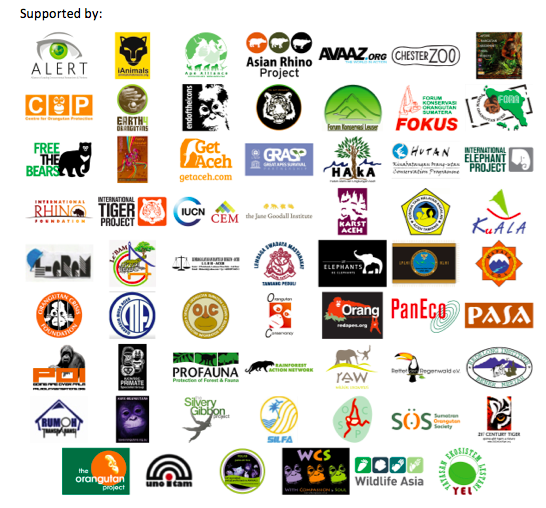
FOR IMMEDIATE RELEASE
Tuesday, September 23rd, 2014
CONTACT:
Laurel Sutherlin, 415.246.0161 Laurel@ran.org
President of Indonesia put to the test at UN Climate Summit over imminent deforestation
NGOs issue a plea for President Susilo Bambang Yudhoyono to cut carbon pollution by protecting the world renowned Leuser Ecosystem
A video of the plea to President Susilo Bambang Yudhoyono is available at: http://www.youtube.com/watch?v=7x5UyXKYnYg
Joint letter to President Susilo Bambang Yudhoyono:
Plea for President of Indonesia to take bold action to combat climate change by rejecting plan to destroy the Leuser Ecosystem
Dear President Susilo Bambang Yudhoyono,
UN Secretary-General Ban Ki-moon has invited global leaders to the UN Climate Summit 2014 on 23 September to motivate bold climate action. An ambitious, visionary approach is now critical: Climate change is happening and is damaging the ecosystems our societies and economies rely upon. It is time for a meaningful global agreement and immediate action.
Indonesia now has the highest deforestation rate in the world[1]. The rate has surpassed that of Brazil, despite Brazil having five times the natural forest cover of Indonesia. Sumatra tops the table for the worst deforestation rate within Indonesia.
Mr President, it doesn’t have to be this way. World leaders are expecting to see their peers taking strong positive action beyond the Climate Summit to put the brakes on the carbon pollution that results from the destruction of the planet’s remaining forests. The very last thing the world wants to see is vast areas of intact forests being signed over for logging and pulp and oil palm plantations: Yet this is exactly the reality facing the Leuser Ecosystem in Sumatra today.
The Leuser Ecosystem is by far Sumatra’s most significant remaining tropical rainforest and it contains some of the richest representations of the biodiversity of Southeast Asia. In fact, it is considered by experts to be one of the world’s “Most irreplaceable areas”[2], ranked overall as the 33rd most irreplaceable area out of over 173,000 protected areas worldwide. It is the last place on earth where orangutans, rhinoceros, elephants and tigers still coexist in the wild. It is worth millions of dollars each year to Indonesia through the ecosystem services it provides to Aceh’s human community. It is also safely storing millions of tonnes of the planet’s carbon in its forest and peat soils. Yet, as we write – at this very moment – local politicians are pushing through a plan to open up the Leuser Ecosystem for logging, oil palm and mining. The plan will also legalise numerous illegal roads which are already cutting through Leuser’s forests.
President Yudhoyono, with only a stroke of your pen you could stop this tragedy and save the Leuser Ecosystem for the benefit of our climate and for generations to come. We are now at a globally historic crossroads. We write to pledge our support to you. We will stand behind you as you take bold action to save the Leuser Ecosystem from destruction. For the sake of the local communities who depend on these forests for their survival and livelihoods, for the sake of our global biodiversity and our climate, please leave an enduring and meaningful green legacy by protecting the Leuser Ecosystem.
Over 1.3 million people have signed a petition urging you to reject the plan to cut down protected rainforests in Aceh. Indonesia’s majestic forests are a global treasure and we encourage engagement with the local community to develop a plan that prioritises truly sustainable development, and protects this fragile ecosystem and the animals that live there.
President Yudhoyono, we the undersigned are appealing to you to demonstrate Indonesia’s commitment to bold climate action by saving the Leuser Ecosystem. We simply cannot secure a safe climate without your help.
Yours sincerely,
Efendi Isma
KPHA (Aceh Forest Care Coalition)

[1] Margono B.A., Potapov P., Turubanova S., Stolle F., & Hansen M. (2014). Primary forest cover loss in Indonesia over 2000-2012. Nature Climate Change, 4, 730–735.
[2] Le Saout, S., Hoffmann, M., Shi, Y., Hughes, A., Bernard, C., Brooks, T., Bertzky, B., Butchart, S.H.M, Badman, T., & Rodrigues, A. S. (2013). Protected areas and effective biodiversity conservation. Science, 342(6160), 803-805.
